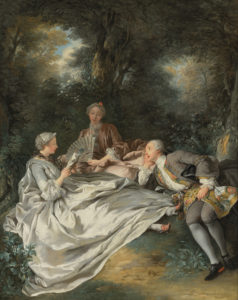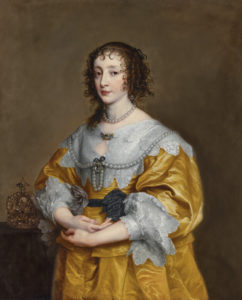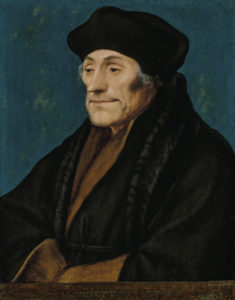
The Reading Party by Jean-François de Troy
On December 8th, Christie’s London featured twenty-seven lots as part of its Old Masters evening sale. This came the day after Sotheby’s held its own rather successful Old Masters sale. While both auctions did relatively well overall, some writers couldn’t help but express some pessimism for the market’s future (w/p = with buyer’s premium).
The stars of the sale were more or less what the specialists had predicted, with Jean-François de Troy’s Reading Party coming out on top. This beautiful 1735 work is one of de Troy’s famous tableaux de mode scenes showing contemporary fashions and pastimes, or what we might call “slice of life” today. Even though de Troy is often categorized as a Rococo painter, his tableaux de mode are often not as sensual or whimsical as the works of his contemporaries like Watteau and Fragonard. But that does not mean that his works are less valuable or admired, as many of his tableaux are considered museum-quality pieces, including The Reading Party. Estimated to sell for between £2M and £3M, the painting hit its mark when the hammer came down at £2.4M / $2.9M (or £2.9M / $3.6M w/p).

Portrait of Queen Henrietta Maria by Sir Anthony van Dyck
While the de Troy gave the end of the sale a bit of excitement, the other two top lots opened everything up with a bang. Sir Anthony van Dyck’s Portrait of Queen Henrietta Maria came in second place at Christie’s that evening. The portrait has an incredibly interesting history: the painting offered at Christie’s is often called the Warwick version since it was owned by seven generations of the Greville family, the Earls of Warwick. The Warwick version is the second, slightly more detailed rendering of a portrait originally commissioned by Queen Henrietta Maria, the wife of King Charles I of England, as a gift to Cardinal Francesco Barberini. The Barberini version is now owned by New York’s Metropolitan Museum of Art. The Warwick version, offered at Christie’s on Thursday, had been up at auction as recently as 2015 when it went unsold at Sotheby’s London with an estimate of £1.5M to £2.5M. But if you look up the pictures of the portrait offered at Sotheby’s, it looks very different from the one featured in last Thursday’s sale. That’s because the Warwick version used to be a full-length portrait. It was altered and extended on behalf of the Earls of Warwick by one of their favorite portraitists, Sir Joshua Reynolds. This was done so that the painting would fit better when hanging in the principal state rooms at Warwick Castle. The portrait has since been restored to its original format, hence the difference in appearance. With such a storied past, it’s a pity that Henrietta Maria wasn’t valued at more than its £2M to £3M estimate. But it seems the house specialists made the right judgment call, as the painting hit its low end at £2M / $2.4M (or £2.4M / $2.9M w/p).
The evening’s third-place lot was another portrait by an equally renowned portraitist. Like Van Dyck, Hans Holbein the Younger is often associated with the English court, with some of his best-known works being portraits of King Henry VIII, Jane Seymour, Thomas Cromwell, Thomas More, and Anne of Cleves. However, he first established his reputation as an artist with his portraits of the Dutch philosopher Erasmus of Rotterdam. The half-length portrait featured at Christie’s on Thursday was a bit of a surprise since the attribution was to “Hans Holbein the Younger and Workshop”. This was notable since art historians are only aware of three existing Erasmus portraits created solely by Holbein, with the others labeled as products of just his workshop or as copies by later artists. There are about thirty-eight portraits identical to the one sold at Christie’s on Thursday, all copies of an original work that has not been found. Arguably, the best example hangs at the Kunstmuseum in Basel, Switzerland. Attributing the work to Holbein and Workshop implies that the artist had more of a hand in the work’s creation than others. Dr. Bodo Brinkmann, the Kunstmuseum’s Old Masters curator, was the one who assigned this attribution, so I suppose that’s reassuring. Against a low estimate of £1M, the Holbein eventually brought in £900K / $1.1M (or £1.1M / $1.4M w/p).

Portrait of Desiderius Erasmus by Hans Holbein the Younger
Overall, Christie’s achieved a sell-through rate of 89%. With seven of the twenty-seven works selling within their estimates, the specialists reached an accuracy rate of 26%. An additional seven works sold above estimate, while ten lots (37%) sold below… only three went unsold. Christie’s eventually brought in £10.6M / $12.9M, just above the £9.6M low estimate. But despite the numbers from both Christie’s and the Sotheby’s sale the previous evening, some commentators were still pessimistic. Scott Reyburn, writing for The Art Newspaper, lamented how both sales featured so few works, blaming post-Brexit tariffs and import delays. He also bemoaned the fact that museum-quality pieces were selling for what amounted to peanuts in the Old Masters markets of years past; that a work by Titian could sell for the same hammer price as (gasp!) a Warhol. Whichever way you look at it, both sales did very well, especially when compared to Old Masters sales in years past.
London Old Masters Week: Christie’s Evening Sale
The Reading Party by Jean-François de Troy
On December 8th, Christie’s London featured twenty-seven lots as part of its Old Masters evening sale. This came the day after Sotheby’s held its own rather successful Old Masters sale. While both auctions did relatively well overall, some writers couldn’t help but express some pessimism for the market’s future (w/p = with buyer’s premium).
The stars of the sale were more or less what the specialists had predicted, with Jean-François de Troy’s Reading Party coming out on top. This beautiful 1735 work is one of de Troy’s famous tableaux de mode scenes showing contemporary fashions and pastimes, or what we might call “slice of life” today. Even though de Troy is often categorized as a Rococo painter, his tableaux de mode are often not as sensual or whimsical as the works of his contemporaries like Watteau and Fragonard. But that does not mean that his works are less valuable or admired, as many of his tableaux are considered museum-quality pieces, including The Reading Party. Estimated to sell for between £2M and £3M, the painting hit its mark when the hammer came down at £2.4M / $2.9M (or £2.9M / $3.6M w/p).
Portrait of Queen Henrietta Maria by Sir Anthony van Dyck
While the de Troy gave the end of the sale a bit of excitement, the other two top lots opened everything up with a bang. Sir Anthony van Dyck’s Portrait of Queen Henrietta Maria came in second place at Christie’s that evening. The portrait has an incredibly interesting history: the painting offered at Christie’s is often called the Warwick version since it was owned by seven generations of the Greville family, the Earls of Warwick. The Warwick version is the second, slightly more detailed rendering of a portrait originally commissioned by Queen Henrietta Maria, the wife of King Charles I of England, as a gift to Cardinal Francesco Barberini. The Barberini version is now owned by New York’s Metropolitan Museum of Art. The Warwick version, offered at Christie’s on Thursday, had been up at auction as recently as 2015 when it went unsold at Sotheby’s London with an estimate of £1.5M to £2.5M. But if you look up the pictures of the portrait offered at Sotheby’s, it looks very different from the one featured in last Thursday’s sale. That’s because the Warwick version used to be a full-length portrait. It was altered and extended on behalf of the Earls of Warwick by one of their favorite portraitists, Sir Joshua Reynolds. This was done so that the painting would fit better when hanging in the principal state rooms at Warwick Castle. The portrait has since been restored to its original format, hence the difference in appearance. With such a storied past, it’s a pity that Henrietta Maria wasn’t valued at more than its £2M to £3M estimate. But it seems the house specialists made the right judgment call, as the painting hit its low end at £2M / $2.4M (or £2.4M / $2.9M w/p).
The evening’s third-place lot was another portrait by an equally renowned portraitist. Like Van Dyck, Hans Holbein the Younger is often associated with the English court, with some of his best-known works being portraits of King Henry VIII, Jane Seymour, Thomas Cromwell, Thomas More, and Anne of Cleves. However, he first established his reputation as an artist with his portraits of the Dutch philosopher Erasmus of Rotterdam. The half-length portrait featured at Christie’s on Thursday was a bit of a surprise since the attribution was to “Hans Holbein the Younger and Workshop”. This was notable since art historians are only aware of three existing Erasmus portraits created solely by Holbein, with the others labeled as products of just his workshop or as copies by later artists. There are about thirty-eight portraits identical to the one sold at Christie’s on Thursday, all copies of an original work that has not been found. Arguably, the best example hangs at the Kunstmuseum in Basel, Switzerland. Attributing the work to Holbein and Workshop implies that the artist had more of a hand in the work’s creation than others. Dr. Bodo Brinkmann, the Kunstmuseum’s Old Masters curator, was the one who assigned this attribution, so I suppose that’s reassuring. Against a low estimate of £1M, the Holbein eventually brought in £900K / $1.1M (or £1.1M / $1.4M w/p).
Portrait of Desiderius Erasmus by Hans Holbein the Younger
Overall, Christie’s achieved a sell-through rate of 89%. With seven of the twenty-seven works selling within their estimates, the specialists reached an accuracy rate of 26%. An additional seven works sold above estimate, while ten lots (37%) sold below… only three went unsold. Christie’s eventually brought in £10.6M / $12.9M, just above the £9.6M low estimate. But despite the numbers from both Christie’s and the Sotheby’s sale the previous evening, some commentators were still pessimistic. Scott Reyburn, writing for The Art Newspaper, lamented how both sales featured so few works, blaming post-Brexit tariffs and import delays. He also bemoaned the fact that museum-quality pieces were selling for what amounted to peanuts in the Old Masters markets of years past; that a work by Titian could sell for the same hammer price as (gasp!) a Warhol. Whichever way you look at it, both sales did very well, especially when compared to Old Masters sales in years past.